The automotive landscape is evolving rapidly, especially with the rise of electric vehicles (EVs). In this article, we will compare two notable entries in the all-electric SUV segment: the Dacia Spring and the Hyundai Inster. Both vehicles aim to provide practical solutions for urban mobility while addressing environmental concerns, yet they do so with different philosophies and technical specifications.
Dacia Spring vs Hyundai Inster – Różnice i ceny w porównaniu
Codzienna jazda, rodzina czy dłuższe trasy – tu widać różnice.
Sprawdź, czy Dacia Spring czy Hyundai Inster lepiej pasuje do Twojego stylu życia.
Overview of the Dacia Spring
The Dacia Spring is redefined for the model year 2024, balancing affordability with essential features. As one of the most budget-friendly electric SUVs on the market, it caters to urban drivers looking for a compact and efficient vehicle.
Specifications of the Dacia Spring
- Body Type: SUV
- Engine Type: Electric
- Transmission: Automatic with Reduction Gearbox
- Drive Type: Front-Wheel Drive
- Power: 44 HP (33 kW) and 65 HP (48 kW)
- Torque: 125 Nm
- Battery Capacity: 26.8 kWh
- Electric Range: Up to 228 km
- Energy Consumption: Between 13.2 to 14.1 kWh/100 km
- Acceleration (0-100 km/h): 13.7 to 19.1 seconds
- Top Speed: 125 km/h
- Curb Weight: Between 1030 to 1050 kg
- Trunk Capacity: 308 L
- Dimensions: Length 3701 mm, Width 1583 mm, Height 1519 mm
Defining Features of the Dacia Spring
The Dacia Spring boasts a compact design that's perfect for city driving, along with a substantial electric range for its class. It emphasizes functional simplicity and accentuates user-friendliness with a spacious trunk and efficient powertrain. The Spring has swiftly garnered attention, not just for its price point but as an entry-level EV that doesn’t compromise on essential specs.
Overview of the Hyundai Inster
On the other hand, the Hyundai Inster, set to debut in 2025, aims to capture the market with its more extensive offerings and technological advancements. It is positioned slightly higher in terms of price and is designed for a diverse range of customer needs, providing a combination of performance and practicality.
Specifications of the Hyundai Inster
- Body Type: SUV
- Engine Type: Electric
- Transmission: Automatic with Reduction Gearbox
- Drive Type: Front-Wheel Drive
- Power: Ranges from 97 HP (71 kW) to 115 HP (85 kW)
- Torque: 147 Nm
- Battery Capacity: 42 to 49 kWh
- Electric Range: Between 360 to 370 km
- Energy Consumption: 14.3 to 15.1 kWh/100 km
- Acceleration (0-100 km/h): 10.6 to 11.7 seconds
- Top Speed: Up to 150 km/h
- Curb Weight: Between 1380 to 1433 kg
- Trunk Capacity: 238 to 280 L
- Dimensions: Length from 3825 to 3845 mm, Width 1610 mm, Height from 1575 to 1610 mm
Defining Features of the Hyundai Inster
The Inster stands out with a more powerful engine range and superior electric range compared to the Spring. The car's larger battery options mean it can cover more significant distances on a single charge, making it a suitable choice for longer commutes and family use. It also comes equipped with a plethora of advanced safety and tech features, appealing to tech-savvy consumers.
Comparative Analysis: Dacia Spring vs Hyundai Inster
In a direct comparison, the Dacia Spring offers remarkable value for the cost-conscious buyer, with a robust design for urban environments. However, for those who require additional performance, higher battery capacity, and more tech features, the Hyundai Inster emerges as the more compelling option. The Inster's more generous electric range and quicker acceleration cater to buyers looking for an overall enhanced driving experience.
Conclusion
Ultimately, the choice between the Dacia Spring and Hyundai Inster boils down to individual needs and preferences. The Spring excels in affordability and simplicity, while the Inster delivers enhanced performance and technology. As the electric vehicle market continues to expand, both offerings illustrate the diverse approaches to sustainable mobility in the auto industry.
Szczegóły techniczne: konkretne różnice między modelami
Koszty i zużycie
Porównanie ceny i zużycia paliwa często pokazuje największe różnice. Tu decyduje się, który model lepiej pasuje do budżetu.
Dacia Spring ma znaczący przewagę cenową – jego cena zaczyna się od 74200 zł, podczas gdy Hyundai Inster kosztuje 105000 zł. Różnica wynosi około 30750 zł.
Pod względem zużycia energii przewagę ma Dacia Spring: z wynikiem 13.20 kWh na 100 km jest prawie niezauważalny bardziej wydajny niż Hyundai Inster, który zużywa 14.30 kWh. Różnica to około 1.10 kWh.
Pod względem zasięgu Hyundai Inster wypada oczywisty lepiej: osiąga do 370 km, czyli około 142 km więcej niż Dacia Spring.
Silnik i osiągi
Moc, moment i przyspieszenie to klasyczne parametry, na których skupiają się entuzjaści – tu widać ciekawe różnice.
Pod względem mocy silnika Hyundai Inster ma decydowany przewagę – 115 KM zamiast 65 KM. To różnica około 50 KM KM.
W przyspieszeniu 0–100 km/h Hyundai Inster jest czytelny szybszy – 10.60 s wobec 13.70 s. Różnica wynosi około 3.10 s sekundy.
Pod względem prędkości maksymalnej Hyundai Inster jest trochę lepszy – osiąga 150 km/h, podczas gdy Dacia Spring kończy na 125 km/h. Różnica to około 25 km/h.
Różnica widoczna jest również w momencie obrotowym: Hyundai Inster ciągnie trochę mocniej – 147 Nm wobec 125 Nm. Różnica to około 22 Nm.
Przestrzeń i praktyczność
Samochód rodzinny czy codzienny towarzysz – który oferuje więcej miejsca, komfortu i elastyczności?
Oba samochody oferują miejsce dla 4 osób.
Pod względem masy własnej Dacia Spring jest wyraźny lżejszy – 1013 kg wobec 1380 kg. Różnica to około 367 kg kg.
Pod względem pojemności bagażnika Dacia Spring oferuje niewielki więcej miejsca – 308 L wobec 280 L. To różnica około 28 L litrów.
W maksymalnej pojemności ładunkowej Hyundai Inster wypada minimalny lepiej – do 1059 L, czyli o około 55 L więcej niż Dacia Spring.
Pod względem ładowności Hyundai Inster wypada nieco lepiej – 357 kg wobec 302 kg. Różnica to około 55 kg kg.
Kto wygrywa pojedynek?
Hyundai Inster okazał się nie daje rywalowi większych szans i tym samym zdobywa tytuł DriveDuel Champion!
W tym porównaniu Hyundai Inster to bardziej wszechstronny wybór.
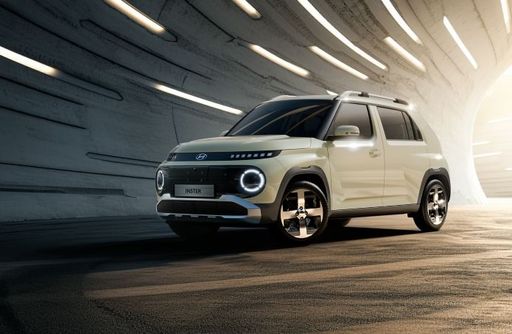 @ Hyundai Motor Company
@ Hyundai Motor Company
Hyundai Inster
Dacia Spring
Dacia Spring to miejski elektryk, który za przystępną cenę oferuje prostotę i praktyczność idealną do codziennych dojazdów. Nie oczekuj luksusu, ale docenisz niskie koszty eksploatacji, zaskakującą przestrzeń wnętrza i łatwość parkowania — to samochód dla rozsądnych kupujących, którzy wolą użyteczność od przepychu.
szczegóły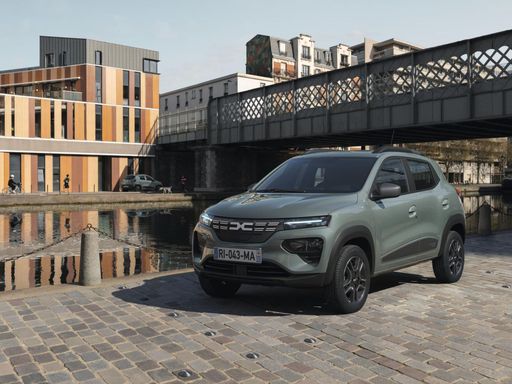 @ Dacia / Renault Group Media
@ Dacia / Renault Group Media
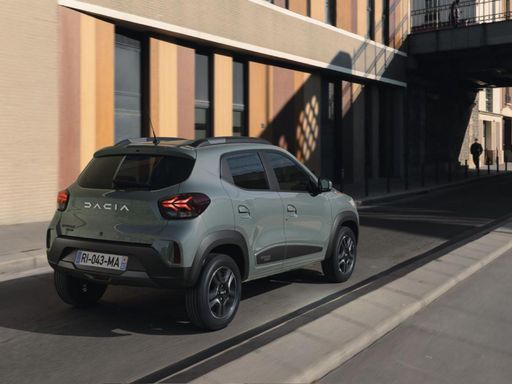 @ Dacia / Renault Group Media
@ Dacia / Renault Group Media
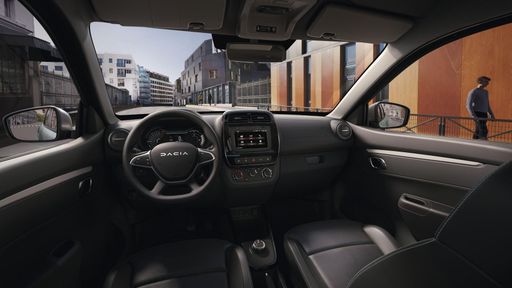 @ Dacia / Renault Group Media
@ Dacia / Renault Group Media
Hyundai Inster
Hyundai Inster to samochód, który zaskakuje świeżym stylem i praktycznym podejściem do codziennej mobilności. Dobrze zestrojone zawieszenie i przestronne wnętrze sprawiają, że to pewny wybór dla tych, którzy chcą komfortu bez przepłacania.
szczegóły @ Hyundai Motor Company
@ Hyundai Motor Company
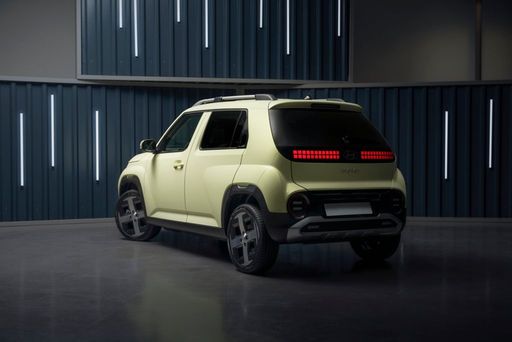 @ Hyundai Motor Company
@ Hyundai Motor Company
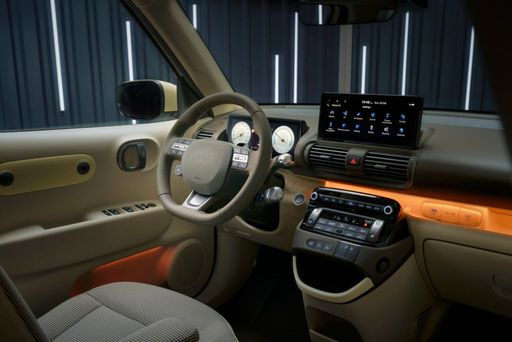 @ Hyundai Motor Company
@ Hyundai Motor Company
 @ Dacia / Renault Group Media
@ Dacia / Renault Group Media
|
 @ Hyundai Motor Company
@ Hyundai Motor Company
|
|
|
|
Koszty i Zużycie |
|
|---|---|
|
Cena
74200 - 87400 zł
|
Cena
105000 - 132200 zł
|
|
Zużycie L/100km
-
|
Zużycie L/100km
-
|
|
Zużycie kWh/100km
13.2 - 14.1 kWh
|
Zużycie kWh/100km
14.3 - 15.1 kWh
|
|
Zasięg elektryczny
225 - 228 km
|
Zasięg elektryczny
327 - 370 km
|
|
Pojemność baterii
26.80 kWh
|
Pojemność baterii
42 - 49 kWh
|
|
CO2
0 g/km
|
CO2
0 g/km
|
|
Pojemność zbiornika paliwa
-
|
Pojemność zbiornika paliwa
-
|
Wymiary i Nadwozie |
|
|---|---|
|
Typ nadwozia
SUV
|
Typ nadwozia
SUV
|
|
Miejsca siedzące
4
|
Miejsca siedzące
4
|
|
Drzwi
5
|
Drzwi
5
|
|
Masa własna
1013 - 1050 kg
|
Masa własna
1380 - 1433 kg
|
|
Pojemność bagażnika
308 L
|
Pojemność bagażnika
238 - 280 L
|
|
Długość
3701 mm
|
Długość
3825 - 3845 mm
|
|
Szerokość
1583 mm
|
Szerokość
1610 mm
|
|
Wysokość
1519 mm
|
Wysokość
1575 - 1610 mm
|
|
Maksymalna pojemność bagażnika
1004 L
|
Maksymalna pojemność bagażnika
1059 L
|
|
Ładowność
265 - 302 kg
|
Ładowność
317 - 357 kg
|
Silnik i Wydajność |
|
|---|---|
|
Typ silnika
Elektryczny
|
Typ silnika
Elektryczny
|
|
Skrzynia biegów
Automatyczna
|
Skrzynia biegów
Automatyczna
|
|
Szczegóły skrzyni biegów
Reduktor
|
Szczegóły skrzyni biegów
Reduktor
|
|
Rodzaj napędu
Napęd na przednie koła
|
Rodzaj napędu
Napęd na przednie koła
|
|
Moc KM
44 - 65 KM
|
Moc KM
97 - 115 KM
|
|
Przyspieszenie 0-100km/h
13.7 - 19.1 s
|
Przyspieszenie 0-100km/h
10.6 - 11.7 s
|
|
Maksymalna prędkość
125 km/h
|
Maksymalna prędkość
140 - 150 km/h
|
|
Moment obrotowy
113 - 125 Nm
|
Moment obrotowy
147 Nm
|
|
Liczba cylindrów
-
|
Liczba cylindrów
-
|
|
Moc kW
33 - 48 kW
|
Moc kW
71 - 85 kW
|
|
Pojemność silnika
-
|
Pojemność silnika
-
|
Ogólne |
|
|---|---|
|
Rok modelowy
2024
|
Rok modelowy
2025
|
|
Klasa efektywności CO2
A
|
Klasa efektywności CO2
A
|
|
Marka
Dacia
|
Marka
Hyundai
|
Jakie rodzaje napędu ma Dacia Spring?
Dacia Spring jest dostępny z napędem Napęd na przednie koła.
Wyświetlane ceny i dane są szacunkowe, oparte na niemieckich cenach katalogowych i mogą się różnić w zależności od kraju. Te informacje nie stanowią wiążącej oferty.
